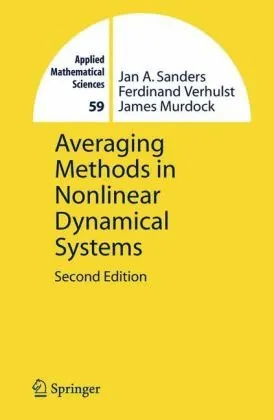Averaging Methods in Nonlinear Dynamical Systems
4.5
Reviews from our users

You Can Ask your questions from this book's AI after Login
Each download or ask from book AI costs 2 points. To earn more free points, please visit the Points Guide Page and complete some valuable actions.Introduction to Averaging Methods in Nonlinear Dynamical Systems
Nonlinear dynamical systems play a vital role in understanding complex behaviors in mechanics, physics, biology, and other scientific fields. These systems often feature intricate interactions that can be difficult to analyze directly. The book Averaging Methods in Nonlinear Dynamical Systems by Jan A. Sanders and Ferdinand Verhulst offers a comprehensive exploration of one of the most powerful tools for approaching such systems: averaging methods.
The field of nonlinear dynamics is incredibly diverse, ranging from classical mechanics to modern numerical simulations. This book meticulously discusses both the foundational theory of nonlinear averaging and its various applications. It is written primarily for graduate students, researchers, and professionals equipped with a background in mathematics, physics, or engineering. However, the text remains accessible, as it balances both rigorous mathematics and intuitive understanding.
Detailed Summary of the Book
Averaging methods stand as a cornerstone technique in the study of nonlinear dynamics. The book explores their theoretical foundations as well as their practical implications. Central to this methodology is the idea of simplifying complex, rapidly oscillating systems into simpler averaged equations that capture essential characteristics without losing critical dynamical information. This approach is particularly powerful for investigating periodic and quasi-periodic systems.
The book is structured around a progressive buildup of concepts. It begins with an introduction to the classical averaging theories and their applications to specific problems, such as the motion of planets in celestial mechanics or the vibrations in engineering systems. Subsequent chapters delve deeper into more advanced topics, such as higher-dimensional manifolds, multi-frequency systems, and advanced perturbative techniques.
Importantly, the authors emphasize both formal and applied aspects of averaging. They present rigorous proofs alongside illustrative examples, ensuring readers gain not only theoretical knowledge but also practical expertise. The book includes both first-order and higher-order averaging techniques, covering topics like asymptotic expansions, bifurcations, and applications in real-world nonlinear systems.
Key Takeaways
- Foundational Understanding: Learn the mathematical foundations of averaging methods, including proofs, derivations, and their limitations.
- Broad Applications: Discover how averaging can be applied in areas like celestial mechanics, fluid dynamics, and nonlinear oscillations.
- Higher-Order Methods: Dive into advanced averaging techniques involving higher-order corrections and multi-frequency systems.
- Practical Insight: Gain a clear understanding of how to translate these abstract methods into real-world problem-solving strategies.
- Rigorous Framework: Grasp the precise mathematical structures underlying the approximation and averaging processes.
Famous Quotes from the Book
"In nonlinear systems, the apparent complexity is often a disguise for underlying simplicity that can be revealed through careful mathematical analysis."
"Averaging, as a mathematical tool, allows us to extract the essential dynamics of a system without drowning in the abundance of its details."
"The art of mathematical modeling lies not merely in solving equations, but in understanding them and transforming them to suit our insights."
Why This Book Matters
The significance of Averaging Methods in Nonlinear Dynamical Systems lies in its ability to bridge theoretical and applied mathematics. Many phenomena in the natural world are governed by nonlinear dynamics, yet their complexity often makes direct study impossible. By introducing averaging methods, this book provides the tools necessary to reduce these systems to more manageable forms while retaining their essential behavior.
With the formal rigor backed by intuitive guidance, this book equips researchers and students alike to tackle a wide range of problems in applied sciences. It emphasizes the universality of averaging methods, demonstrating their power to simplify problems in celestial mechanics, fluid stability, nonlinear vibrations, and many other domains.
Additionally, the clear and structured progression of topics ensures accessibility to readers at varying levels of expertise. Experts will appreciate the depth of coverage on advanced methods, whereas newcomers will find the gradual introduction to foundational concepts approachable and enlightening.
In an era where nonlinear dynamics is increasingly relevant due to advances in computational power and expanding scientific research, this book remains not only relevant but indispensable. It embodies the intersection of theory, application, and insight—qualities that make it a timeless resource for understanding and leveraging the power of nonlinear systems.
Free Direct Download
You Can Download this book after Login
Accessing books through legal platforms and public libraries not only supports the rights of authors and publishers but also contributes to the sustainability of reading culture. Before downloading, please take a moment to consider these options.
Find this book on other platforms:
WorldCat helps you find books in libraries worldwide.
See ratings, reviews, and discussions on Goodreads.
Find and buy rare or used books on AbeBooks.
1203
بازدید4.5
امتیاز50
نظر98%
رضایتReviews:
4.5
Based on 0 users review
"کیفیت چاپ عالی بود، خیلی راضیام"


